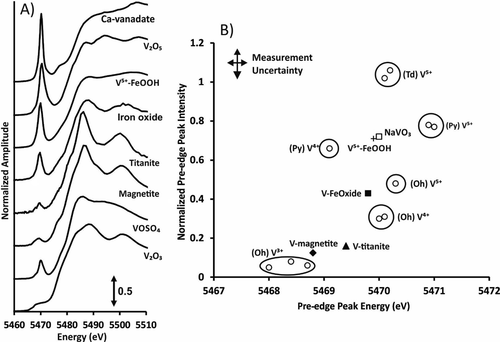
Electron microprobe X-ray maps showing V-bearing titanite and magnetite in Mount Polley tailings (POL-5) and V-bearing Fe oxide in the Fe oxyhydroxide (Fe oxyhyd) (POL-13).
Mount Polley, British Columbia, Canada is a copper and gold mine, producing waste (tailings) containing mostly silicate minerals (feldspars, ferro-magnesian and Ca-Ti-silicates, and muscovite), oxides such as magnetite and rutile, carbonates, and small amounts of copper sulfides and pyrite. The mine tailings have elevated concentrations of vanadium compared to local background soils, and following the failure of the tailings dam in 2014, there was concern about vanadium contamination downstream. Vanadium occurs naturally in four oxidation states (V2+, V3+, V4+, and V5+). Although vanadium is an essential element for humans and animals, high concentrations can be carcinogenic and toxic. V5+ is considered to be the most toxic vanadium species, as it can inhibit or replace phosphate. There is, however, a lack of information about, and understanding of, the geochemical–mineralogical cycling of vanadium in mining-affected environments, which is required to determine health effects and to develop management and remediation schemes. In work recently published in Environmental Science & Technology, a team of researchers present the first evidence that dissolution of vanadium-bearing magnetite and titanite may contribute to aqueous vanadium, and that natural chemical processes can result in an attenuation of vanadium levels.
On 4 August 2014, an earthen dam at Mount Polley Mine in British Columbia failed, releasing more than 10 million cubic metres of water (enough to fill 4,000 Olympic-sized pools) and 4.5 million cubic metres of tailings sand into local lakes. The waste travelled down Hazeltine Creek, swelling it from its normal size of about a metre to over 150 metres in width. The release of these mine wastes led to a water-use ban in nearby towns, which was not lifted until 12 August 2014. At the time, this was the second largest tailing dam failure (by volume).

Image of Mount Polley from 29 July, 2014, before the dam breach. Image Credit: NASA Earth Observatory images by Jesse Allen, using Landsat data from the U.S. Geological Survey.

Image of Mount Polley from 5 August, 2014, after the dam breach. Image Credit: NASA Earth Observatory images by Jesse Allen, using Landsat data from the U.S. Geological Survey.
Professor Karen Hudson-Edwards has been part of a multi-disciplinary team studying tailings dam failures since 1998. The team received NERC Urgency Grant funding to study the environmental aftermath of the Mount Polley dam failure, looking at both the physical and chemical impacts. The mine had identified the elements of concern - copper, selenium and vanadium. As Prof. Hudson-Edwards explains,
Vanadium is an emerging contaminant. We don’t know much about its toxicity in the ecosystem and how it behaves in the environment. So this situation was quite new, and a challenge to understand it.
The team were interested in the redox (reduction–oxidation reaction) chemistry, and the different species of vanadium that were formed in the environment. They focused their investigations on Hazeltine Creek, which had been scoured by the released wastes as they flowed down to the lake, uprooting trees on the way. Mine tailings mixed with organic matter under water, burying organic waste and causing reducing conditions. The aim of the project was to understand the geochemical cycling of vanadium in the Hazeltine Creek catchment and its implications for the environmental impact of vanadium in other river systems.

Being able to investigate the vanadium speciation at Diamond really helped us to finish this story. We couldn’t have done it without the invaluable assistance of the beamline staff, who particularly helped with processing the data, which isn’t an everyday task for most scientists.
The results of this work will inform restoration and management schemes for river systems receiving vanadium from natural and anthropogenic sources.

Location of the study area showing the Hazeltine Creek stream (HC-), inflow sample, pore water (PW-) and tailings, sediment, and Fe oxyhydroxide (POL-) sample sites for materials collected in 2014 and 2015. Labels shown are for those samples discussed in this work.
Since this research was undertaken, extensive cleanup of the mine spill has removed most of the spilled tailings from the creek, and restored it. The aim of this remedial work was to restore ecosystem habitats through the establishment of a new rock-lined channel, reducing remobilisation of the remaining tailings and exposed natural sediments and decreasing turbidity.
To find out more about the I18 beamline, or to discuss potential applications, please contact Principal Beamline Scientist Konstantin Ignatyev: konstantin.ignatyev@diamond.ac.uk.
Hudson-Edwards KA et al. Origin and Fate of Vanadium in the Hazeltine Creek Catchment following the 2014 Mount Polley Mine Tailings Spill in British Columbia, Canada. Environmental Science & Technology 53, 4088−4098 (2019). DOI:10.1021/acs.est.8b06391
Diamond Light Source is the UK's national synchrotron science facility, located at the Harwell Science and Innovation Campus in Oxfordshire.
Copyright © 2022 Diamond Light Source
Diamond Light Source Ltd
Diamond House
Harwell Science & Innovation Campus
Didcot
Oxfordshire
OX11 0DE
Diamond Light Source® and the Diamond logo are registered trademarks of Diamond Light Source Ltd
Registered in England and Wales at Diamond House, Harwell Science and Innovation Campus, Didcot, Oxfordshire, OX11 0DE, United Kingdom. Company number: 4375679. VAT number: 287 461 957. Economic Operators Registration and Identification (EORI) number: GB287461957003.